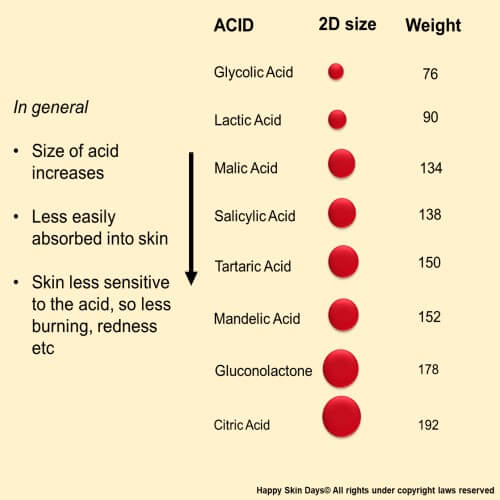(All references supporting the acid series are available at this LINK)
Introduction and trends in use
Glycolic Acid or 2- Hyrdoxyacetic Acid is the smallest Alpha Hydroxy Acid (AHA) and is the most commonly used AHA in skincare products.
Glycolic Acids have been used in chemical peels for over 40 years. Even when used in chemical peels (e.g., over a six week period), the dose of Glycolic Acid is gradually increased depending on the skin’s adaptability and tolerance.
Structure
Glycolic Acid really is tiny – its half the size of Gluconolactone, a Poly Hydroxy Acid.

Benefits
As an exfoliator, it accelerates epidermal cellular turnover, exposing new skin, that is younger looking and glowing – (this skin has simply not been exposed to the elements before). The effects of this, can be seen as soon as 24 hours after treatment.
Regular use should:
- Increases epidermal thickness – so skin firming
- Smooth skin
- Diminish fine lines and wrinkles
- Reduce hyperpigmentation**
** Of course, with darker-skinned individuals, this may not happen.
10% Glycolic Acid
This has clinically proven benefits for photodamaged skin. It helps with other signs of aging (fine lines, wrinkles, mottled pigmentation, skin laxity, large pore size, skin roughness).
(Side note on desquamation: see below)
Side-effects
Photo-sensitivity is a side-effect of using Glycolic Acid. This means that you need less exposure to UV radiation to achieve the same level of UV damage because your skin is now more sensitive to UV radiation.
In the same study, the author writes that the photo-sensitivity disappears after 1 week of discontinuation of Glycolic Acid. I couldn’t find anything after that.
The following should think of using this acid
Caucasians: skin types I – III. Given the aggressive action of Glycolic Acid, I have found that a lot of people recommend it to “mature”, “photo-damaged skin.”
The bottom line is anyone can use it but initially in very small concentration and infrequently. For example, if you are in your 30s then using a 1% – 5% once a week and building this to higher tolerance as you get older is a good place to start.
In your 20s, your skincare focus should be sun protection and not necessarily Glycolic Acid. I would not start with Glycolic Acid but a less aggressive acid such as Mandelic Acid.
The following should consider not using this acid
This is not an exhaustive list, but generally if you have:
- Sensitive skin (including photo-sensitivity
- Difficulties finding new products, because your skin reacts poorly
- Acne prone skin
- Rosacea and so on, then you should give Glycolic Acid a wide berth.
If you have dark skin (Fitzpatrick skin type IV, V or VI), you should give Glycolic Acid a wide berth.
Products for first time users?
Start with a low concentration and if the glycolic acid is under 1% than that’s a good start. Please do not forget your sunscreen which I would recommend is not below SPF 30.
I’ve been through 500+ products on Sephora’s American website and trust me, there are not many standalone low percentage Glycolic Acid products. So far, I’ve found two products I would be happy to use. If I find more, I’ll add them to this blog.
Glow Recipe Blueberry Bounce Gentle Cleanser (has both Glycolic Acid and Lactic Acid)
Dr Roebuck’s Lifesaver Skin Brightening Toner
Note on desquamation
As we get older, “keratinization” of the facial skin increases: corneocytes (dead cells) in the topmost layer of our skin (the Stratum Corneum), stick together more tightly becoming harder to remove.
Also, as we age, the skin’s natural ability to desquamate decreases. Desquamation is a natural cellular process whereby our epidermis renews itself every 28 days. As we get older this process slows down and (e.g.) can reach 40 days. This results in roughness, sallowness, uneven skintone, hyper-pigmentation, lines and wrinkles.

Source: Milstone, Epidermal Desquamation, Journal of Dermatological Science, Volume 36, Issue 3, December 2004, 131-140Glycolic Acid (as do other AHAs) can be described as:
Diminishing the corneocyte cohesion immediately above the granular layer: the corneocytes in the Stratum Corneum detach and desquamate OR
Promoting desquamation by weakening the “glue” or the desmosomes* between corneocytes.
